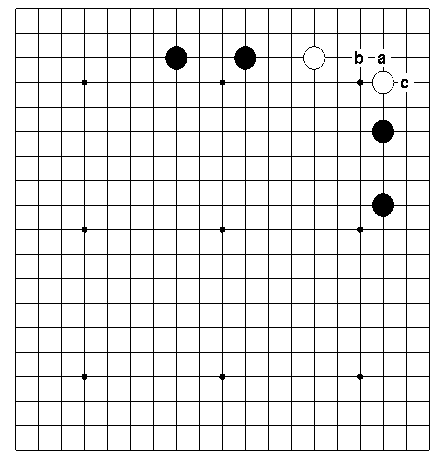
The LA Go Club (at 740 S. Western Ave. #210, LA 90005; [213] 386-5626) hums with activity both on weekday evenings and the weekends. Dozens of strong players gather to meet with their friends and slap some stones on one of the 50 or so boards arrayed on tables in a number of connecting rooms. At its busiest, a tournament might be in progress while attendants bustle around to serve the players, whether by bringing drinks, snacks or cigarettes, emptying ashtrays, or even serving meals brought up from the restaurant downstairs. (As a matter of fact, the restaurant's daily specials are posted on a bulletin board in the club! But you'd better be able to read Korean or have an adventurous palate before ordering one of those meals!)
Weaker players (and other Americans who are intimidated by an exotic Oriental subculture) sometimes feel out of place when considering the strength of the average player there, but all feel welcome and appreciative of the Sunday afternoon go lessons that the club offers. The lectures are held in a non-smoking room equipped with a large demonstration board and furnished with plush, comfortable chairs arranged around low tables on which new, three inch thick go boards have been placed. Around the room, the walls display the accouterments of a tasteful, well-connected go club: scrolls exhibiting exquisite samples of calligraphy with go-related themes; framed documents from the Korean Go Association (Hanguk Kiwon) certifying the club as a full-fledged affiliate branch, another certifying owner Gary Choi as amateur 5 dan and still another authorizing Gary to own and operate the club; photographs of famous players, for example, Cho Namchul 8 dan (uncle of Cho Chikun and regarded as the father of Korean go) standing next to Gary, Kim In 9 dan with Lee Changho 6 dan; and other decorations. Looking out the window one sees, written in large letters, the Korean characters (hangul) that spell out "Los Angeles Go Classroom". All in all, it is a perfect setting for a memorable learning experience.
And most memorable of all is the lecturer: Yang Yilun 6 dan. Yang Sensei is rightly regarded as one of the finest teachers of go in America. His lessons are always pertinent, lively, enlightening, and, all agree, conducted on a personal level: one always feels involved and that Sensei is concerned that one gets the most out of the lesson. If you have never had an opportunity to attend one of Sensei's lectures, you have been deprived of one of the most enjoyable experiences a go player can have. The following report of one lesson is an attempt to convey some sense of what goes on during Sensei's lectures, but it pales in comparison with the real thing. One must attend oneself to get a true appreciation of Sensei's skill.

At 3 PM Sensei steps up to the demonstration board and places two white stones in the corner, as illustrated in Diagram 1. "Okay, every-body, what do you think of this corner enclosure? It's kind of unusual, isn't it? You don't see it often in your games, do you? It has weaknesses, though, doesn't it? Do you know where those weaknesses are? Of course those weaknesses don't become apparent until there are opponent's stones in the area.
With that Sensei places the black stones on the board. "Who can tell me where the weaknesses in this corner are?" Then he points to someone in the audience. "What do you say?" "I think the 3-3 point is the biggest weakness." "Okay, thank you. He says a. How about you," continues Sensei, pointing at another listener. "Maybe b." "Thank you. How about you?" "I think c is a weak point." "Thank you," says Sensei and continues until all have given a response. Then he examines the choices.
"We can dismiss c as an endgame move. It's certainly too early to play it here, when there are other, more important weaknesses to exploit. Someone thought that the 3-3 point is the biggest weakness. That is correct. The basic variation to consider is that of Diagram 2. Black lives easily with the sequence to 7. And please remember to play the move at 7 in situations like this. Can anyone tell me why?" Immediately a voice called out: "It makes definite eyes in the corner!" Obviously, that was a regular student of Sensei's lectures who had taken his teachings to heart. "Yes! Of course it does!" Sensei remarked with a delighted look.
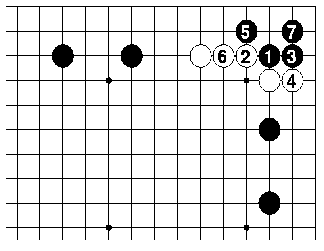
He then asked another person about the move at b."Well," was the reply, "if black's stone on the upper side was one point to the right, black could play at 1 and 3 in Diagram 3, but it doesn't work here." "Exactly!" Sensei exclaimed. "The variation in question follows the exchange of black a for white b, then black plays c. White cuts with d and f, and black aims to make use of the ataris at g and i. Now if black's stone was one point closer, at j, the white stones would be subject to atari in a ladder to the edge of the board. But as pointed out, that is no good."
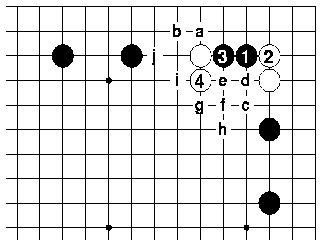
Sensei then subtly alters the situation as in Diagram 4. Here black's stone on the upper side is one point closer to the white group, but the black invasion at 1 is still no good since white has an extension on the right side. "Now white can embarrass black by attacking at 6. So you have to be more creative."
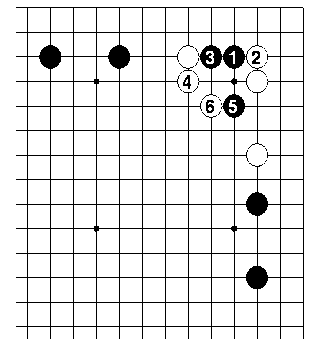
"First black must play a diversion with black 1 in Diagram 5. When white responds 2, black can dive in the corner with 3. But what is the best response to white 4?"
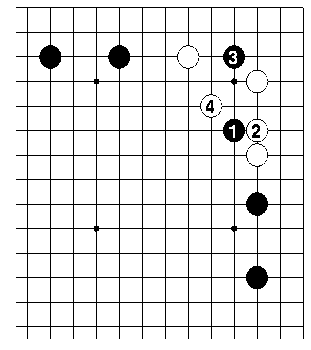
At this point Sensei asked the audience to split into 2 groups for individual attention. Each one consisted of five or six people gathered around a go board. Sensei then proceeded to review the lesson in detail, first by asking the group to demonstrate the vital points and the model variations he had just lectured on. Then he took up the test question in Diagram 5. "What would you do if white came at you with the off-beat move of 4 in Diagram 5?" "I would rejoice in my heart!" a confident student piped up.
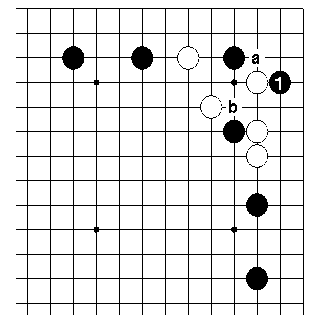
"Ah!" said Sensei, chuckling. "Someone knows that it is a weak move!" Then he asked all where the vital point was. Most of the students chose the 3-3 point of a in Diagram 6. But then a white move at 1 puts white on the spot. Then the confident student pointed out that black 1 is correct. "Ah! A tricky move! You can see that black is aiming at the point of b. The variation in Diagram 7 leaves a weakness at a."
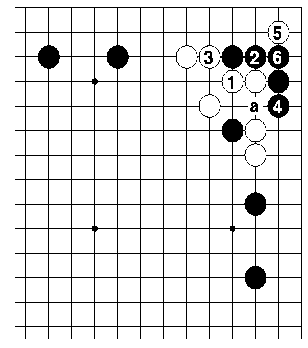
After a few concluding remarks, Sensei dismissed the class. It had been another delightful day at the LA Go Club.